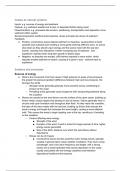Coasts as natural systems
Inputs: e.g. sources of energy and sediment
Outputs: e.g. sediment washed out to sea, or deposited further along coast
Flows/transfers: e.g. processes like erosion, weathering, transportation and deposition move
sediment within system
Stores/components: landforms like beaches, dunes and spits are stores of sediment
Feedback:
● Positive: constructive waves deposit sediment on beaches, causing them to build
upwards and outwards and creating a more gently shelving offshore zone, so waves
slow down as they absorb wave energy and the waves meet with the sea bed
sooner, causing more deposition, further increasing size of beaches - new
equilibrium reached when long-term growth of beach stops
● Negative: as beaches are eroded, cliffs behind exposed to wave action, which
deposits eroded sediment on beach, causing it to grow in size - restores back to
equilibrium
Systems and processes
Sources of energy
● Wind is the movement of air from areas of high pressure to areas of low pressure;
the greater the pressure gradient (difference between high and low pressure), the
stronger the winds
○ Stronger winds generally generate more powerful waves contributing to
erosion at the coast
○ Prevailing winds generally cause longshore drift, transporting sediment along
the coastline
● Waves are caused as the wind blows over the surface of the open ocean, building up
friction which causes ripples that develop in size as waves. Waves generally have a
circular orbit upon formation and throughout their fetch. As they reach the coastline,
the base of the wave meets with the sea bed, building up friction that reduces the
wave’s energy and length but increases the wave height, causing a more elliptical
orbit. This causes the wave to begin toppling over at the top, resulting in it breaking
on the coastline.
○ Factors affecting wave energy:
■ Strength of the wind
■ Duration of the wind: if wind is active for longer periods of time, higher
energy waves generated
■ Size of the fetch: distance over which the wind blows without
disturbance
○ Waves can be of 2 types:
■ Constructive waves are less powerful, lower energy waves, typically
created in general open ocean weather conditions. They have a long
wavelength, and a low wave frequency and height, with a strong
swash and a weak backwash that causes deposition on the coast -
usually associated with low-energy coastlines and therefore
depositional landforms like beaches.
, ■ Destructive waves are more powerful, high energy waves, typically
created in storm conditions. They have a short wavelength, and a high
wave frequency and height, with a weak swash and a strong
backwash that causes erosion on the coast - usually associated with
high energy coastlines and therefore erosional landforms like cliffs and
headlands.
● Tides are the periodic rise and fall of the ocean surface as a result of the gravitational
pull of the Sun and moon; the tidal range is the difference between the low tide and
high tide. A spring tide is caused when the Sun and moon are in alignment with the
Earth, producing a large tidal range, whereas a neap tide is caused when the moon
is at a right angle to the Sun, producing a smaller tidal range. Tides determine
whereabouts and the duration of which waves break on the coastline, resulting in the
formation of different landforms. Areas of the shore between maximum high tide and
minimum low tide is where most landforms are created.
● Currents are the general flow of water in one direction caused by wind, water density
differences due to temperature and salinity variations, and gravity, that typically
transport sediment along the coastline.
High-energy coasts:
● Typically face more destructive, powerful waves that result in erosion exceeding
deposition
● Caused by strong winds, long fetches, more resistant igneous geology like granite,
and steeply shelving offshore zones
● Develops rocky erosional landforms such as cliffs, headlands, wave-cut platforms,
coves, caves, arches, stacks and stumps.
Low-energy coasts:
● Typically face more constructive, weaker waves that result in deposition exceeding
erosion
● Caused by gentler winds, shorter fetches, less resistant sedimentary geology like
limestone, gently sloping offshore zones (cause waves to slow down/lose their
energy before they break on the coastline due to friction between the base of the
wave and the sea bed) and offshore islands (cause waves to break/lose most of their
energy before reaching the coastline)
● Develops sandy depositional landforms like beaches, spits and estuarine
mudflats/salt marshes.
Sources of sediment
● Sediment that is weathered and eroded from cliffs faces and deposited
● Mass movement, like surface runoff and landslides, and rivers transport sediment
from inland into the coast
● Waves, tides and currents transport sediment from offshore deposits like sandbanks
● Sediment inputted from the crushed shells of marine organisms like phytoplankton
● Sea levels rise can flood river valleys, forming estuaries and sediment becomes part
of coast
Sediment cells:




